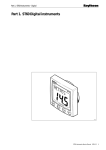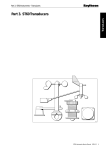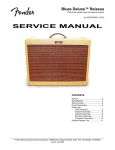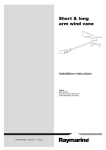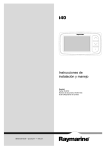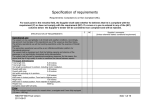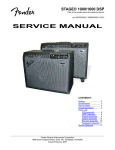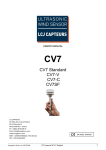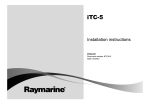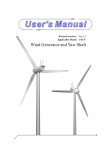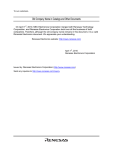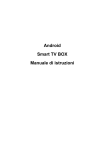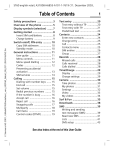Download ST 60 Analog Instruments Service Manual
Transcript
Part 2. ST60 Instruments – Analogue Part 2. ST60 Analogue instruments D4468-3 ST60 Instruments Service Manual 83142-1 i Part 2. ST60 Instruments – Analogue Contents ST60 Analogue instrument exploded view ........................................................................ iv Chapter 1. ST60 Wind instrument .................................................................................... 1 Disassembly/reassembly ............................................................................................ 1 PCB identification ...................................................................................................... 1 Self-test procedure ...................................................................................................... 1 Self-test stage 1 ................................................................................................. 1 Self-test stage 2 ................................................................................................. 2 Self-test stage 3 ................................................................................................. 2 Self-test stage 4 ................................................................................................. 3 Useful PCB test points ................................................................................................ 4 ST60 Wind spare parts list ........................................................................................... 5 ST60 Wind PCB details .............................................................................................. 6 Input/Output signals .......................................................................................... 6 ST60 Wind circuit diagram ................................................................................ 7 ST60 Wind PCB layout............................................................................................... 8 ST60 Wind PCB component list ........................................................................ 9 Chapter 2. ST60 CH Wind instrument............................................................................ 11 Disassembly/reassembly .......................................................................................... 11 PCB identification .................................................................................................... 11 Self-test procedure .................................................................................................... 11 Self-test stage 1 ............................................................................................... 11 Self-test stage 2 ............................................................................................... 12 Self-test stage 3 ............................................................................................... 13 Useful PCB test points .............................................................................................. 13 ST60 CH Wind spare parts list ................................................................................... 15 ST60 CH Wind PCB details ...................................................................................... 16 Input/Output signals ........................................................................................ 16 ST60 CH Wind circuit diagram ........................................................................ 17 ST60 CH Wind PCB layout ...................................................................................... 18 ST60 CH Wind PCB component list ................................................................ 19 Chapter 3. ST60 Compass instrument ............................................................................ 21 Disassembly/reassembly .......................................................................................... 21 PCB identification .................................................................................................... 21 Self-test procedure .................................................................................................... 21 Self-test stage 1 ............................................................................................... 21 Self-test stage 2 ............................................................................................... 22 Self-test stage 3 ............................................................................................... 22 Self-test stage 4 ............................................................................................... 23 ii ST60 Instruments Service Manual 83142-1 Part 2. ST60 Instruments – Analogue Useful PCB test points .............................................................................................. 23 ST60 Compass spare parts list ................................................................................... 25 ST60 Compass PCB details ...................................................................................... 26 Input/Output signals ........................................................................................ 26 ST60 Compass circuit diagram ........................................................................ 27 ST60 Compass PCB layout ....................................................................................... 28 ST60 Compass PCB component list ................................................................. 29 Chapter 4. ST60 Rudder Angle Indicator instrument ..................................................... 31 Disassembly/reassembly .......................................................................................... 31 PCB identification .................................................................................................... 31 Self-test procedure .................................................................................................... 31 Self-test stage 1 ............................................................................................... 31 Self-test stage 2 ............................................................................................... 32 Self-test stage 3 ............................................................................................... 32 Self-test stage 4 ............................................................................................... 33 Useful PCB test points .............................................................................................. 33 ST60 Rudder Angle Indicator spare parts list .............................................................. 35 ST60 Rudder Angle Indicator PCB details ................................................................. 36 Input/Output signals ........................................................................................ 36 ST60 Rudder Angle Indicator circuit diagram ................................................... 37 ST60 Rudder Angle Indicator PCB layout .................................................................. 38 ST60 Rudder Angle Indicator component list ................................................... 39 Chapter 5. ST60 Clubhouse Wind instrument ................................................................ 41 Disassembly/reassembly .......................................................................................... 41 PCB identification .................................................................................................... 41 Self-test procedure .................................................................................................... 41 Self-test stage 1 ............................................................................................... 41 Self-test stage 2 ............................................................................................... 42 Self-test stage 3 ............................................................................................... 42 Self-test stage 4 ............................................................................................... 43 Useful PCB test points .............................................................................................. 43 ST60 Clubhouse Wind spare parts list ........................................................................ 45 ST60 Clubhouse Wind PCB details ........................................................................... 46 Input/Output signals ........................................................................................ 46 ST60 Clubhouse Wind circuit diagram ............................................................. 47 ST60 Clubhouse Wind PCB layout ............................................................................ 48 ST60 Clubhouse Wind PCB component list ..................................................... 49 ST60 Instruments Service Manual 83142-1 iii Figure 1: ST60 Wind, CH Wind, Compass and Rudder Angle Indicator Digital Instrument exploded view iv ST60 Instruments Service Manual 83142-1 1 18 2 Flush mounting Assembly 2 6 3 19(x4) Torque 0.33Nm (3lb in) 20 4 21 5 7 (Note A) 8 (Note B) 9 (Note A) 11 1. Facia bezel 2. Keypad 3. Facia 4. Inner keypad 5. Shroud 6. Pointer 7. Display label 8. LCD analogue display 9. Diffuser 10. Reflector 11. PCB assembly 17 D4449-1 12. Case seal 13. Rear case 14. Washer (x3) 15. Screw (x11) 16. Label (rear case) 17. Gasket 18. Flush mount bezel 19. Screw (x4) 20. Flush mount seal 21. Rear bracket 15 (x8) Torque 0.22Nm(2lbin) 16 14 15 (x3) (x3) Torque 0.22Nm(2lbin) 12 (Note C) 13 A. Display label (7) and Diffuser (9) fitted to the Rudder Angle Indicator do not have an LCD aperture. B. LCD analogue display (8) is not fitted to a Rudder Angle Indicator. C. It is recommended that a new case seal (12) is fitted on re-assembly. Note: 10 Part 2. ST60 Instruments – Analogue ST60 Analogue instrument exploded view Part 2. ST60 Instruments –Chapter 1. Wind Chapter 1. ST60 Wind instrument Disassembly/reassembly On reassembly (refer to Figure 1), it is important that the PCB assembly module is fixed to the facia (3) using a torque of 0.22Nm (2lb in). Similarly, fixing the rear case (13) to the facia (3) must also be torqued to 0.22Nm (2lb in). Note: Failure to practice using the recommended torques may result in damage to the facia inserts. It is also recommended a new case seal (12) is fitted on reassembly. PCB identification WI: CH: CO: RU: Wind and Clubhouse Wind CH Wind Compass Rudder Angle Indicator D4492-1 Self-test procedure The ST60 Wind instrument has built-in self-test functions to aid fault diagnosis. To access self-test mode, press Key 1 and Key 4 together for 4 seconds. When the unit beeps, immediately press Key 3 and Key 4 together momentarily. The unit will enter self-test stage 1. Self-test stage 1 A. The unit should display S t followed by T1. B. There will be a SeaTalk transmission to check the transmit/receive circuits. C. The EEPROM is tested. The following failure codes may be generated: Message Failure Mode Action F01 SeaTalk Rx/Tx Check for damaged bucket connectors/rear-case pins. Check SeaTalk interface components around TR3 and TR5. F02 EEPROM failure Replace EEPROM (IC8) If there is no audible beep, generated by the key presses, check around TR2 and TR6 and the buzzer for damage. If the beep is quiet, check R79. If all tests pass, P is shown on the display. Press Key 1 and Key 2 together momentarily to progress to self-test stage 2. ST60 Instruments Service Manual 83142-1 1 A22005 To aid identification of PCBs an identifying component has been included in the top left hand corner of the populated PCB. Part 2. ST60 Instruments – Chapter 1. Wind Self-test stage 2 A. The unit should display T2 for 1 second. B. Illumination will change between level 0 and level 3 every second. C. Any key press will cause audible beep. D. The pointer will rotate continuously. This will highlight a problem if the pointer makes contact with the dial or window. E. LCD segments will cycle through the following sequence: 1 2 3 D4491-1 A22005 No fail codes are generated since stage 2 is an audio/visual check. The following can, however, be used as a guide to isolate a problem: Failure Mode Action Keypad Illumination failure (Dial illumination will also be degraded). Check TR9, TR11, R78 and R91a. Check LEDs 1, 4, 7 and 8 for open circuit. Keypad illumination OK but degraded Dial illumination. Check TR10, TR11, R75 and R91b. Check LEDs 13 - 16 for open circuit. No beep when key pressed. Replace keyswitch. LCD segment(s) missing completely. Check LCD solder pins for poor/dry joints. Check IC3 for unsoldered pins. Faint LCD segments. Check LCD pins for shorts. Check IC3 for shorts. Pointer not rotating or erratic movement. Check motor winding continuity. Approximately 150 ohms between TP135 and TP136 and between TP142 and TP143. When the pointer has completed at least one rotation, press Key 1 and Key 2 together momentarily to progress to self-test stage 3. Self-test stage 3 This stage is to set up pointer offset and corrections. On entry the LCD will show T3 and then indicate the position to which the pointer should be positioned to adjust for pointer offset. Momentary presses of Key 1 will rotate the pointer clockwise to align with the major graduations. Should there be any misalignment repeatedly press Key 3 for anti-clockwise or Key 4 for clockwise adjustment until correct alignment is obtained on all major graduations. On completion of correction adjustments press Key 1 and Key 2 together momentarily to progress to self-test stage 4. 2 ST60 Instruments Service Manual 83142-1 Part 2. ST60 Instruments –Chapter 1. Wind Self-test stage 4 Note: This stage can be completed with either a Rotavecta transducer or Windvane transducer connected. A. The unit should display T4. B. Perform transducer operation as described below. Rotavecta. Spin the rotavecta buckets. The display will show P for a pass or F5 for a failure. Windvane. Spin the annemometer, then turn the vane in a complete circle. The display will show P for a pass, F3 for a failed windvane test or F4 for a failed annemometer test. Check Action Rotavecta signal: Turn rotavecta cups and check voltage at P13 switches between approximately 3V and 8V. • Constant current supply at P13 present. Check around TR1 and IC4c. • 0V supply at P14 present. Check L11 open circuit. • Check ROTAPRES (IC4 pin 14) is low. Annemometer signal: Turn annemometer and check voltage at P13 switches between approximately 2V and 8V. • Check L7 and R13 for open circuit. • 8V supply at P7. Check L4, R84 for open circuit. • 0V supply at P11 present. Check L8 for open circuit. • Check around IC4b. Wind vane signal: Slowly turn vane through 360°. Signal at SIN (P8) and COS (P4) should vary between approximately 2.2V and 5.8V. • 8V supply at P7 present. Check L4, R84 for open circuit. • 0V supply at P11 present. Check L8 for open circuit. If the above is OK then the problem probably lies within the ADC circuit. • Check L5,L6, R52, R82 for open circuit. • Check ADC circuit around IC5 and IC6. To exit self-test and store pointer corrections press Key 1 and Key 2 together for 2 seconds. If storage of pointer corrections is not required press Key 1 and Key 2 together momentarily to exit. ST60 Instruments Service Manual 83142-1 3 A22005 If the test fails, check the following ensuring the transducer is connected: Part 2. ST60 Instruments – Chapter 1. Wind Useful PCB test points Vcc 5V TP10 0V TP14 8V, transducer supply TP80 Display illumination PWM TP81 Key illumination PWM TP191 SeaTalk receive TP110 Integrator output (ADC) TP119 ADC interupt TP135 Motor drive Sin B TP136 Motor drive Sin A TP143 Motor drive Cos B TP142 Motor drive Cos A A22005 TP7 4 ST60 Instruments Service Manual 83142-1 Part 2. ST60 Instruments –Chapter 1. Wind ST60 Wind spare parts list The item numbers refer to Figure 1: ST60 Analogue Instrument exploded view Item Spare/Accessory Description Part No. 1 Facia bezel A25001 – Suncover, standard A25004 Not illustrated 2 Keypad,Wind A28015 Pack of 5 Facia with case seal, including Facia Case seal Washer (x3) Screw (x11) A28013 3 12 14 15 Inner keypad, including Inner keypad Case seal Washer (x3) Screw (x11) A28022 4 12 14 15 5 Shroud, Wind A28048 6 Pointer A28041 Pack of 5 7 Display label,Wind A28043 Pack of 5 8 LCD, analogue display A28025 PCB and dial assembly, Wind including A28004 6 7 8 9 10 11 12 14 15 Comments See A28027 Torque to 0.22Nm (2lb in) See A28027 Pointer Display label, Wind LCD, analogue display Diffuser Reflector PCB assembly Case seal Washer (x3) Screw (x11) Assembled module consisting of items 6, 7, 8, 9, 10,11. See A28041 See A28043 See A28025 See A28027 Torque to 0.22Nm (2lb in) 12 Case seal A28027 Pack of 5 Rear case assembly, including Case seal Rear case Screw (x8) A28014 12 13 15 16 Label,Wind (rear case) A28039 Pack of 5 17 Gasket A28028 Pack of 5 18 Flush mount bezel A25002 Flush mount kit, including Suncover, flush mount Flush mount bezel Screw (x4) Flush mount seal Rear bracket A25003 – 18 19 20 21 See A28027 Torque to 0.22Nm (2lb in) Not illustrated See A25002 Torque to 0.33Nm (3lb in) ST60 Instruments Service Manual 83142-1 5 A22005 Torque to 0.22Nm (2lb in) Part 2. ST60 Instruments – Chapter 1. Wind ST60 Wind PCB details Input/Output signals Rear case connection Signal Description A (Red) 12V EXT Nominal 12V DC supply B (Screen) 0V EXT OV C (Yellow) DATA Intermittent streams of (nominal) 12V pulses D (Red) 12V EXT Nominal 12V DC supply E (Screen) 0V EXT OV F (Yellow) DATA Intermittent streams of (nominal) 12V pulses G (Red) 8V Vane supply H (Green) SIN sin output J (Blue) COS cos output K (Yellow) ANN annemometer L (White) SCREEN Transducer OV return N (Red) ROTA+ Rotavecta current constant P (Blue) ROTA– Rotavecta 0V A B CD E F P G A22005 (refer to Figure 2. ST60 Wind circuit diagram) N M RO J L K H TA N VA Rear case connections to ST60 Wind instrument 6 ST60 Instruments Service Manual 83142-1 E D4486-1 Part 2. ST60 Instruments –Chapter 1. Wind A22005 D4463-1 ST60 Wind circuit diagram Figure 2. ST60 Wind circuit diagram ST60 Instruments Service Manual 83142-1 7 Part 2. ST60 Instruments – Chapter 1. Wind A22005 ST60 Wind PCB layout Taken from Drawing No: 4318-002 Issue: E Date: 26-10-98 8 ST60 Instruments Service Manual 83142-1 D4471-1 Part 2. ST60 Instruments –Chapter 1. Wind A22005 ST60 Wind PCB component list Taken from Drawing No: 4318-002 Issue: E Date: 26-10-98 D4472-1 ST60 Instruments Service Manual 83142-1 9 A22005 Part 2. ST60 Instruments – Chapter 1. Wind 10 ST60 Instruments Service Manual 83142-1 Part 2. ST60 Instruments – Chapter 2. CH Wind Chapter 2. ST60 CH Wind instrument Disassembly/reassembly On reassembly (refer to Figure 1), it is important that the PCB assembly module is fixed to the facia (3) using a torque of 0.22Nm (2lb in). Similarly, fixing the rear case (13) to the facia (3) must also be torqued to 0.22Nm (2lb in). Note: Failure to practice using the recommended torques may result in damage to the facia inserts. It is also recommended a new case seal (12) is fitted on reassembly. PCB identification To aid identification of PCBs an identifying component has been included in the top left hand corner of the populated PCB. WI: CH: CO: RU: Wind and Clubhouse Wind CH Wind Compass Rudder Angle Indicator D4493-1 The ST60 CH Wind instrument has built-in self-test functions to aid fault diagnosis. To access self-test mode, press Key 1 and Key 4 together for 4 seconds. When the unit beeps, immediately press Key 3 and Key 4 together momentarily. The unit will enter self-test stage 1. Self-test stage 1 A. The unit should display S t followed by T1. B. There will be a SeaTalk transmission to check the transmit/receive circuits. C. The EEPROM is tested. The following failure codes may be generated: Message Failure Mode Action F01 SeaTalk Rx/Tx Check for damaged bucket connectors/rear-case pins. Check SeaTalk interface components around TR3 and TR5. F02 EEPROM failure Replace EEPROM (IC8) If there is no audible beep, generated by the key presses, check around TR2 and TR6 and the buzzer for damage. If the beep is quiet, check R79. If all tests pass, P is shown on the display. Press Key 1 and Key 2 together momentarily to progress to self-test stage 2. ST60 Instruments Service Manual 83142-1 11 A22006 Self-test procedure Part 2. ST60 Instruments – Chapter 2. CH Wind Self-test stage 2 A. The unit should display T2 for 1 second. B. Illumination will change between level 0 and level 3 every second. C. Any key press will cause audible beep. D. The pointer will rotate continuously. This will highlight a problem if the pointer makes contact the dial or window. E. LCD segments will cycle through the following sequence: 1 2 3 D4491-1 A22006 No fail codes are generated since stage 2 is an audio/visual check. The following can, however, be used as a guide to isolate a problem: Failure Mode Action Keypad Illumination failure (Dial illumination will also be degraded). Check TR9, TR11, R78 and R91a. Check LEDs 1, 4, 7 and 8 for open circuit. Keypad illumination OK but degraded Dial illumination. Check TR10, TR11, R75 and R91b. Check LEDs 13 - 16 for open circuit. No beep when key pressed. Replace keyswitch. LCD segment(s) missing completely. Check LCD solder pins for poor/dry joints. Check IC3 for unsoldered pins. Faint LCD segments. Check LCD pins for shorts. Check IC3 for shorts. Pointer not rotating or erratic movement. Check motor winding continuity. Approximately 150 ohms between TP135 and TP136 and between TP142 and TP143. When the pointer has completed at least one rotation, press Key 1 and Key 2 together momentarily to progress to self-test stage 3. 12 ST60 Instruments Service Manual 83142-1 Part 2. ST60 Instruments – Chapter 2. CH Wind Self-test stage 3 This stage is to set up pointer offset and corrections. On entry the LCD will show T3 and then indicate the position to which the pointer should be positioned to adjust for pointer offset. Momentary presses of Key 1 will rotate the pointer clockwise to align with the major graduations. Should there be any misalignment repeatedly press Key 3 for anti-clockwise or Key 4 for clockwise adjustment until correct alignment is obtained on all major graduations. On completion of correction adjustments press K1 and K2 together momentarily to exit self-test stage 3. The unit will display t4 for 1 second and then P for pass. To exit self-test and store pointer corrections press Key 1 and Key 2 together for 2 seconds. If storage of pointer corrections is not required press Key 1 and Key 2 together momentarily to exit. TP7 Vcc 5V TP10 0V TP80 Display illumination PWM TP81 Key illumination PWM TP191 SeaTalk receive TP135 Motor drive Sin B TP136 Motor drive Sin A TP143 Motor drive Cos B TP142 Motor drive Cos A A22006 Useful PCB test points ST60 Instruments Service Manual 83142-1 13 Part 2. ST60 Instruments – Chapter 2. CH Wind A22006 This page is intentionally left blank 14 ST60 Instruments Service Manual 83142-1 Part 2. ST60 Instruments – Chapter 2. CH Wind ST60 CH Wind spare parts list The item numbers refer to Figure 1: ST60 Analogue Instrument exploded view Item Spare/Accessory Description Part No. 1 Facia bezel A25001 – Suncover, standard A25004 Not illustrated 2 Keypad, CH Wind A28015 Pack of 5 Facia with case seal, including Facia Case seal Washer (x3) Screw (x11) A28013 3 12 14 15 Inner keypad, including Inner keypad Case seal Washer (x3) Screw (x11) A28022 4 12 14 15 5 Shroud, CH Wind A28049 6 Pointer A28041 Pack of 5 7 Display label, CH Wind A28044 Pack of 5 8 LCD, analogue display A28025 PCB and dial assembly, CH Wind including A28005 See A28027 Torque to 0.22 Nm (2lb in) See A28027 Torque to 0.22 Nm (2lb in) Pointer Display label, CH Wind LCD, analogue display Diffuser Reflector PCB assembly Case seal Washer (x3) Screw (x11) Assembled module consisting of items 6, 7, 8, 9, 10,11. See A28041 See A28044 See A28025 See A28027 Torque to 0.22 Nm (2lb in) 12 Case seal A28027 Pack of 5 Rear case assembly, including Case seal Rear case Screw (x8) A28014 12 13 15 16 Label, CH Wind (rear case) A28040 Pack of 5 17 Gasket A28028 Pack of 5 18 Flush mount bezel A25002 Flush mount kit, including Suncover, flush mount Flush mount bezel Screw (x4) Flush mount seal Rear bracket A25003 – 18 19 20 21 See A28027 Torque to 0.22 Nm (2lb in) Not illustrated See A25002 Torque to 0.33 Nm (3lb in) ST60 Instruments Service Manual 83142-1 15 A22006 6 7 8 9 10 11 12 14 15 Comments Part 2. ST60 Instruments – Chapter 2. CH Wind ST60 CH Wind PCB details Input/Output signals (refer to Figure 3. ST60 CH Wind circuit diagram) Rear case connection Signal Description A (Red) 12V EXT Nominal 12V DC supply B (Screen) 0V EXT OV C (Yellow) DATA Intermittent streams of (nominal) 12V pulses D (Red) 12V EXT Nominal 12V DC supply E (Screen) 0V EXT OV F (Yellow) DATA Intermittent streams of (nominal) 12V pulse B CD E F P G A M RO J L K H TA A22006 N N VA Rear case connections to ST60 CH Wind instrument 16 ST60 Instruments Service Manual 83142-1 E D4487-1 Part 2. ST60 Instruments – Chapter 2. CH Wind A22006 D4464-1 ST60 CH Wind circuit diagram Figure 3. ST60 CH Wind circuit diagram ST60 Instruments Service Manual 83142-1 17 Part 2. ST60 Instruments – Chapter 2. CH Wind A22006 ST60 CH Wind PCB layout Taken from Drawing No: 4319-002 Issue: E Date: 26-10-98 18 ST60 Instruments Service Manual 83142-1 D4473-1 Part 2. ST60 Instruments – Chapter 2. CH Wind A22006 ST60 CH Wind PCB component list Taken from Drawing No: 4319-002 Issue: E Date: 26-10-98 D4474-1 ST60 Instruments Service Manual 83142-1 19 A22006 Part 2. ST60 Instruments – Chapter 2. CH Wind 20 ST60 Instruments Service Manual 83142-1 Part 2. ST60 Instruments – Chapter 3. Compass Chapter 3. ST60 Compass instrument Disassembly/reassembly On reassembly (refer to Figure1), it is important that the PCB assembly module is fixed to the facia (3) using a torque of 0.22Nm (2lb in). Similarly, fixing the rear case (13) to the facia (3) must also be torqued to 0.22Nm (2lb in). Note: Failure to practice using the recommended torques may result in damage to the facia inserts. It is also recommended a new case seal (12) is fitted on reassembly. PCB identification To aid identification of PCBs an identifying component has been included in the top left hand corner of the populated PCB. WI: CH: CO: RU: Wind and Clubhouse Wind CH Wind Compass Rudder Angle Indicator D4494-1 Self-test procedure The ST60 Compass instrument has built-in self-test functions to aid fault diagnosis. Self-test stage 1 A. The unit should display S t followed by T1. B. There will be a SeaTalk transmission to check the transmit/receive circuits. C. The EEPROM is tested. The following failure codes may be generated: Message Failure Mode Action F01 SeaTalk Rx/Tx Check for damaged bucket connectors/rear-case pins. Check SeaTalk interface components around TR3 and TR5. F02 EEPROM failure Replace EEPROM (IC8) If there is no audible beep, generated by the key presses, check around TR2 and TR6 and the buzzer for damage. If the beep is quiet, check R79. If all tests pass, P is shown on the display. Press Key 1 and Key 2 together momentarily to progress to self-test stage 2. ST60 Instruments Service Manual 83142-1 21 A22007 To access self-test mode, press Key 1 and Key 4 together for 4 seconds. When the unit beeps, immediately press Key 3 and Key 4 together momentarily. The unit will enter self-test stage 1. Part 2. ST60 Instruments – Chapter 3. Compass Self-test stage 2 A. The unit should display T2 for 1 second. B. Illumination will change between level 0 and level 3 every second. C. Any key press will cause audible beep. D. The pointer will rotate continuously. This will highlight a problem if the pointer makes contact the dial or window. E. LCD segments will cycle through the following sequence: 1 2 3 D4491-1 A22007 No fail codes are generated since stage 2 is an audio/visual check. The following can, however, be used as a guide to isolate a problem: Failure Mode Action Keypad Illumination failure (Dial illumination will also be degraded). Check TR9, TR11, R78 and R91a. Check LEDs 1, 4, 7 and 8 for open circuit. Keypad illumination OK but degraded Dial illumination. Check TR10, TR11, R75 and R91b. Check LEDs 13 - 16 for open circuit. No beep when key pressed. Replace keyswitch. LCD segment(s) missing completely. Check LCD solder pins for poor/dry joints. Check IC3 for unsoldered pins. Faint LCD segments. Check LCD pins for shorts. Check IC3 for shorts. Pointer not rotating or erratic movement. Check motor winding continuity. Approximately 150 ohms between TP135 and TP136 and between TP142 and TP143. When the pointer has completed at least one rotation, press Key 1 and Key 2 together momentarily to progress to self-test stage 3. Self-test stage 3 This stage is to set up pointer offset and corrections. On entry the LCD will show T3 and then indicate the position to which the pointer should be positioned to adjust for pointer offset. Momentary presses of Key 1 will rotate the pointer clockwise to align with the major graduations. Should there be any misalignment repeatedly press Key 3 for anti-clockwise or Key 4 for clockwise adjustment until correct alignment is obtained on all major graduations. On completion of correction adjustments press Key 1 and Key 2 together momentarily to progress to self-test stage 4. 22 ST60 Instruments Service Manual 83142-1 Part 2. ST60 Instruments – Chapter 3. Compass Self-test stage 4 Note: This stage to be completed with fluxgate transducer connected. A. The unit should display T4. B. Turn the fluxgate carefully through one rotation. The display will show P for a pass or F6 for a failure. If the test fails, check the following with no transducer connected: Check Action VREF (P7) – 2.5V • Check R48, L4 for open circuit. • Check VRESET = 2.5V. SCREEN (P11) – tied to 0V • Check L8 for open circuit. FGDRV – repetitive pulse train TP97 or P10. • Check L7 for open circuit. • Check pulse train present either side of C17. • Check drive circuit components around TR7 and TR8. If the above are OK then the problem probably lies within the ADC circuit. • Check L5,L6, R52 and R82 for open circuit. • Check ADC circuit around IC5 and IC6. To exit self-test and store pointer corrections press Key 1 and Key 2 together for 2 seconds. If storage of pointer corrections is not required press Key 1 and Key 2 together momentarily to exit. TP7 Vcc 5V TP10 0V TP80 Display illumination PWM TP81 Key illumination PWM TP191 SeaTalk receive TP110 Integrator output (ADC) TP119 ADC interupt TP135 Motor drive Sin B TP136 Motor drive Sin A TP143 Motor drive Cos B TP142 Motor drive Cos A TP97 Fluxgate A22007 Useful PCB test points ST60 Instruments Service Manual 83142-1 23 Part 2. ST60 Instruments – Chapter 3. Compass A22007 This page is intentionally left blank 24 ST60 Instruments Service Manual 83142-1 Part 2. ST60 Instruments – Chapter 3. Compass ST60 Compass spare parts list The item numbers refer to Figure 1: ST60 Analogue Instrument exploded view Item Spare/Accessory Description Part No. 1 Facia bezel A25001 – Suncover, standard A25004 Not illustrated 2 Keypad, Compass A28017 Pack of 5 Facia with case seal, including Facia Case seal Washer (x3) Screw (x11) A28013 3 12 14 15 Inner keypad, including Inner keypad Case seal Washer (x3) Screw (x11) A28022 4 12 14 15 5 Shroud, Compass A28050 6 Pointer A28041 Pack of 5 7 Display label, Compass A28047 Pack of 5 8 LCD, analogue display A28025 PCB and dial assembly, Compass including A28007 See A28027 Torque to 0.22Nm (2lb in) See A28027 Torque to 0.22Nm (2lb in) Pointer Display label, Compass LCD, analogue display Diffuser Reflector PCB assembly Case seal Washer (x3) Screw (x11) Assembled module consisting of items 6, 7, 8, 9, 10,11. See A28041 See A28047 See A28025 See A28027 Torque to 0.22Nm (2lb in) 12 Case seal A28027 Pack of 5 Rear case assembly, including Case seal Rear case Screw (x8) A28014 12 13 15 16 Label, Compass (rear case) A28038 Pack of 5 17 Gasket A28028 Pack of 5 18 Flush mount bezel A25002 A25003 – 18 19 20 21 Flush mount kit, including Suncover, flush mount Flush mount bezel Screw (x4) Flush mount seal Rear bracket See A28027 Torque to 0.22Nm (2lb in) Not illustrated See A25002 Torque to 0.33Nm (3lb in) ST60 Instruments Service Manual 83142-1 25 A22007 6 7 8 9 10 11 12 14 15 Comments Part 2. ST60 Instruments – Chapter 3. Compass ST60 Compass PCB details Input/Output signals (refer to Figure 4. ST60 Compass circuit diagram) Rear case connection Signal Description A (Red) 12V EXT Nominal 12V DC supply B (Screen) 0V EXT OV C (Yellow) DATA Intermittent streams of (nominal) 12V pulses D (Red) 12V EXT Nominal 12V DC supply E (Screen) 0V EXT OV F (Yellow) DATA Intermittent streams of (nominal) 12V pulses G (Red) VREF Fluxgate 2.5V H (Yellow) FGA Sense A J (Green) FGB Sense B K (Blue) FGDRV Fluxgate drive L (White) Screen Fluxgate OV return A B CD E F P RO A22007 G M N J L K H TA COM Rear case connections to ST60 Compass instrument 26 ST60 Instruments Service Manual 83142-1 S PA S D4488-1 Part 2. ST60 Instruments – Chapter 3. Compass A22007 D4465-1 ST60 Compass circuit diagram Figure 4. ST60 Compass circuit diagram ST60 Instruments Service Manual 83142-1 27 Part 2. ST60 Instruments – Chapter 3. Compass A22007 ST60 Compass PCB layout Taken from Drawing No: 4320-002 Issue: E Date: 26-10-98 28 ST60 Instruments Service Manual 83142-1 D4475-1 Part 2. ST60 Instruments – Chapter 3. Compass A22007 ST60 Compass PCB component list Taken from Drawing No: 4320-002 Issue: E Date: 26-10-98 D4476-1 ST60 Instruments Service Manual 83142-1 29 A22007 Part 2. ST60 Instruments – Chapter 3. Compass 30 ST60 Instruments Service Manual 83142-1 Part 2. ST60 Instruments – Chapter 4. Rudder Angle Indicator Chapter 4. ST60 Rudder Angle Indicator instrument Disassembly/reassembly On reassembly (refer to Figure 1), it is important that the PCB assembly module is fixed to the facia (3) using a torque of 0.22Nm (2lb in). Similarly, fixing the rear case (13) to the facia (3) must also be torqued to 0.22Nm (2lb in). Note: Failure to practice using the recommended torques may result in damage to the facia inserts. It is also recommended a new case seal (12) is fitted on reassembly. PCB identification To aid identification of PCBs an identifying component has been included in the top left hand corner of the populated PCB. WI: CH: CO: RU: Wind and Clubhouse Wind CH Wind Compass Rudder Angle Indicator D4495-1 Self-test procedure The ST60 Rudder Angle Indicator instrument has built-in self-test functions to aid fault diagnosis. To access self-test mode, press Key 1 and Key 4 together for 4 seconds. When the unit beeps, immediately press Key 3 and Key 4 together momentarily. The unit will enter self-test stage 1. Self-test stage 1 B. The EEPROM is tested. After 2 seconds a single beep will indicate a pass. A double beep at this point indicates one of the tests has failed. Failure Mode Action SeaTalk Rx/Tx Check for damaged bucket connectors/rear-case pins. Check SeaTalk interface components around TR3 and TR5. EEPROM failure Replace EEPROM (IC8) If there is no audible beep, generated by the key presses, check around TR2 and TR6 and the buzzer for damage. If the beep is quiet, check R79. Press Key 1 and Key 2 together momentarily to progress to self-test stage 2. ST60 Instruments Service Manual 83142-1 31 A22008 A. There will be a SeaTalk transmission to check the transmit/receive circuits. Part 2. ST60 Instruments – Chapter 4. Rudder Angle Indicator Self-test stage 2 A. Illumination will change between level 0 and level 3 every second. B. Any key press will cause audible beep. C. The pointer will rotate continuously. This will highlight a problem if the pointer makes contact the dial or window. No fail codes are generated since stage 2 is an audio/visual check. The following can, however, be used as a guide to isolate a problem: Failure Mode Action Keypad Illumination failure (Dial illumination will also be degraded). Check TR9, TR11, R78 and R91a. Check LEDs 1, 4, 7 and 8 for open circuit. Keypad illumination OK but degraded Dial illumination. Check TR10, TR11, R75 and R91b. Check LEDs 13 - 16 for open circuit. No beep when key pressed. Replace keyswitch. Pointer not rotating or erratic movement. Check motor winding continuity. Approximately 150 ohms between TP135 and TP136 and between TP142 and TP143. When the pointer has completed at least one rotation, press Key 1 and Key 2 together momentarily to progress to self-test stage 3. Self-test stage 3 This stage is to set up pointer offset and corrections. On entry the pointer will come to rest. Using Key 3 and Key 4 move the pointer to the top position. Momentary presses of Key 1 will rotate the pointer clockwise to align with the major graduations. Should there be any misalignment repeatedly press Key 3 for anti-clockwise or Key 4 for clockwise adjustment until correct alignment is obtained on all major graduations. A22008 On completion of correction adjustments press Key 1 and Key 2 together momentarily to progress to self-test stage 4. 32 ST60 Instruments Service Manual 83142-1 Part 2. ST60 Instruments – Chapter 4. Rudder Angle Indicator Self-test stage 4 Note: This stage to be completed with a Rudder Reference transducer connected. Movement of the Rudder Reference transducer should be shown as movement by the pointer. If the pointer oscillates at the top of the dial then the Rudder Reference transducer has failed. If the test fails, check the following ensuring the transducer is connected: Check Action VRUD (P8) should vary either side of 2.5V as transducer is moved. • 5V supply at P7 present. Check L4, R81 for open circuit. • 0V supply at P9 present. Check L15 for open circuit. If the above is OK then the problem probably lies within the ADC circuit. • Check L5, R52 for open circuit. • Check ADC circuit around IC5 and IC6. To exit self-test and store pointer corrections press Key 1 and Key 2 together for 2 seconds. If storage of pointer corrections is not required press Key 1 and Key 2 together momentarily to exit. TP7 Vcc 5V TP10 0V TP80 Display illumination PWM TP81 Key illumination PWM TP191 SeaTalk receive TP110 Integrator output (ADC) TP119 ADC interupt TP135 Motor drive Sin B TP136 Motor drive Sin A TP143 Motor drive Cos B TP142 Motor drive Cos A A22008 Useful PCB test points ST60 Instruments Service Manual 83142-1 33 Part 2. ST60 Instruments – Chapter 4. Rudder Angle Indicator A22008 This page is intentionally left blank 34 ST60 Instruments Service Manual 83142-1 Part 2. ST60 Instruments – Chapter 4. Rudder Angle Indicator ST60 Rudder Angle Indicator spare parts list The item numbers refer to Figure 1: ST60 Analogue Instrument exploded view Item Spare/Accessory Description Part No. Comments 1 Facia bezel A25001 – Suncover, standard A25004 Not illustrated 2 Keypad, Rudder A28016 Pack of 5 Facia with case seal, including Facia Case seal Washer (x3) Screw (x11) A28013 3 12 14 15 Inner keypad, including Inner keypad Case seal Washer (x3) Screw (x11) A28022 4 12 14 15 5 Shroud, Rudder A28051 6 Pointer A28041 Pack of 5 7 Display label, Rudder A28046 Pack of 5 A28006 6 7 9 10 11 12 14 15 PCB and dial assembly, Rudder including Pointer Display label, Rudder Diffuser Reflector PCB assembly Case seal Washer (x3) Screw (x11) Assembled module consisting of items 6, 7, 9, 10, 11. See A28041 See A28046 12 Case seal A28027 Rear case assembly, including Case seal Rear case Screw (x8) A28014 12 13 15 16 Label, Rudder (rear case) A28037 Pack of 5 17 Gasket A28028 Pack of 5 18 Flush mount bezel A25002 Flush mount kit, including Suncover, flush mount Flush mount bezel Screw (x4) Flush mount seal Rear bracket A25003 – 18 19 20 21 See A28027 Torque to 0.22 Nm (2lb in) See A28027 Torque to 0.22 Nm (2lb in) See A28027 Torque to 0.22 Nm (2lb in) Pack of 5 Torque to 0.22 Nm (2lb in) Not illustrated See A25002 Torque to 0.33 Nm (3lb in) ST60 Instruments Service Manual 83142-1 35 A22008 See A28027 Part 2. ST60 Instruments – Chapter 4. Rudder Angle Indicator ST60 Rudder Angle Indicator PCB details Input/Output signals (refer to Figure 5. ST60 Rudder Angle Indicator circuit diagram) Rear case connection Signal Description A (Red) 12V EXT Nominal 12V DC supply B (Screen) 0V EXT OV C (Yellow) DATA Intermittent streams of (nominal) 12V pulses D (Red) 12V EXT Nominal 12V DC supply E (Screen) 0V EXT OV F (Yellow) DATA Intermittent streams of (nominal) 12V pulses G (Red) 5V Transducer +V supply H (Blue) VRUD Transducer output J (Green) OV Transducer 0V return K (White) Screen Transducer screen A B CD E F G M N P RO J L K H R TA RU A22008 Rear case connections to ST60 Rudder instrument 36 ST60 Instruments Service Manual 83142-1 DD E D4489-1 Part 2. ST60 Instruments – Chapter 4. Rudder Angle Indicator A22008 D4466-1 ST60 Rudder Angle Indicator circuit diagram Figure 5. ST60 Rudder Angle Indicator circuit diagram ST60 Instruments Service Manual 83142-1 37 Part 2. ST60 Instruments – Chapter 4. Rudder Angle Indicator A22008 ST60 Rudder Angle Indicator PCB layout Taken from Drawing No: 4377-002 Issue: E Date: 26-10-98 38 ST60 Instruments Service Manual 83142-1 D4477-1 Part 2. ST60 Instruments – Chapter 4. Rudder Angle Indicator A22008 ST60 Rudder Angle Indicator component list Taken from Drawing No: 4377-002 Issue: E Date: 26-10-98 D4478-1 ST60 Instruments Service Manual 83142-1 39 A22008 Part 2. ST60 Instruments – Chapter 4. Rudder Angle Indicator 40 ST60 Instruments Service Manual 83142-1 Part 2. ST60 Instruments – Chapter 5. Clubhouse Wind Chapter 5. ST60 Clubhouse Wind instrument Disassembly/reassembly On reassembly (refer to Figure 1), it is important that the PCB assembly module is fixed to the facia (3) using a torque of 0.22Nm (2lb in). Similarly, fixing the rear case (13) to the facia (3) must also be torqued to 0.22Nm (2lb in). Note: Failure to practice using the recommended torques may result in damage to the facia inserts. It is also recommended a new case seal (12) is fitted on reassembly. PCB identification To aid identification of PCBs an identifying component has been included in the top left hand corner of the populated PCB. WI: CH: CO: RU: Wind and Clubhouse Wind CH Wind Compass Rudder Angle Indicator D4492-1 Self-test procedure The ST60 Wind instrument has built-in self-test functions to aid fault diagnosis. To access self-test mode, press Key 1 and Key 4 together for 4 seconds. When the unit beeps, immediately press Key 3 and Key 4 together momentarily. The unit will enter self-test stage 1. Self-test stage 1 A. The unit should display S t followed by T1. B. There will be a SeaTalk transmission to check the transmit/receive circuits. C. The EEPROM is tested. Message Failure Mode Action F01 SeaTalk Rx/Tx Check for damaged bucket connectors/rear-case pins. Check SeaTalk interface components around TR3 and TR5. F02 EEPROM failure Replace EEPROM (IC8) If there is no audible beep, generated by the key presses, check around TR2 and TR6 and the buzzer for damage. If the beep is quiet, check R79. If all tests pass, P is shown on the display. Press Key 1 and Key 2 together momentarily to progress to self-test stage 2. ST60 Instruments Service Manual 83142-1 41 A22016 The following failure codes may be generated: Part 2. ST60 Instruments – Chapter 5. Clubhouse Wind Self-test stage 2 A. The unit should display T2 for 1 second. B. Illumination will change between level 0 and level 3 every second. C. Any key press will cause audible beep. D. The pointer will rotate continuously. This will highlight a problem if the pointer makes contact the dial or window. E. LCD segments will cycle through the following sequence: 1 2 3 D4491-1 No fail codes are generated since stage 2 is an audio/visual check. The following can, however, be used as a guide to isolate a problem: Failure Mode Action Keypad Illumination failure (Dial illumination will also be degraded). Check TR9, TR11, R78 and R91a. Check LEDs 1, 4, 7 and 8 for open circuit. Keypad illumination OK but degraded Dial illumination. Check TR10, TR11, R75 and R91b. Check LEDs 13 - 16 for open circuit. No beep when key pressed. Replace keyswitch. LCD segment(s) missing completely. Check LCD solder pins for poor/dry joints. Check IC3 for unsoldered pins. Faint LCD segments. Check LCD pins for shorts. Check IC3 for shorts. Pointer not rotating or erratic movement. Check motor winding continuity. Approximately 150 ohms between TP135 and TP136 and between TP142 and TP143. When the pointer has completed at least one rotation, press Key 1 and Key 2 together momentarily to progress to self-test stage 3. A22016 Self-test stage 3 This stage is to set up pointer offset and corrections. On entry the LCD will show T3 and then indicate the position to which the pointer should be positioned to adjust for pointer offset. Momentary presses of Key 1 will rotate the pointer clockwise to align with the major graduations. Should there be any misalignment repeatedly press Key 3 for anti-clockwise or Key 4 for clockwise adjustment until correct alignment is obtained on all major graduations. On completion of correction adjustments press Key 1 and Key 2 together momentarily to progress to self-test stage 4. 42 ST60 Instruments Service Manual 83142-1 Part 2. ST60 Instruments – Chapter 5. Clubhouse Wind Self-test stage 4 Note: This stage can be completed with a Windvane transducer connected. A. The unit should display T4. B. Perform transducer operation as described below. Spin the annemometer, then turn the vane in a complete circle. The display will show P for a pass, F3 for a failed windvane test or F4 for a failed annemometer test. If the test fails, check the following ensuring the transducer is connected: Check Action Annemometer signal: Turn annemometer and check voltage at P13 switches between approximately 2V and 8V. • Check L7 and R13 for open circuit. • 8V supply at P7. Check L4, R84 for open circuit. • 0V supply at P11 present. Check L8 for open circuit. • Check around IC4b. Wind vane signal: Slowly turn vane through 360°. Signal at SIN (P8) and COS (P4) should vary between approximately 2.2V and 5.8V. • 8V supply at P7 present. Check L4, R84 for open circuit. • 0V supply at P11 present. Check L8 for open circuit. If the above is OK then the problem probably lies within the ADC circuit. • Check L5,L6, R52, R82 for open circuit. • Check ADC circuit around IC5 and IC6. To exit self-test and store pointer corrections press Key 1 and Key 2 together for 2 seconds. If storage of pointer corrections is not required press Key 1 and Key 2 together momentarily to exit. TP7 Vcc 5V TP10 0V TP14 8V, transducer supply TP80 Display illumination PWM TP81 Key illumination PWM TP191 SeaTalk receive TP110 Integrator output (ADC) TP119 ADC interupt TP135 Motor drive Sin B TP136 Motor drive Sin A TP143 Motor drive Cos B TP142 Motor drive Cos A A22016 Useful PCB test points ST60 Instruments Service Manual 83142-1 43 Part 2. ST60 Instruments – Chapter 5. Clubhouse Wind A22016 This page is intentionally left blank 44 ST60 Instruments Service Manual 83142-1 Part 2. ST60 Instruments – Chapter 5. Clubhouse Wind ST60 Clubhouse Wind spare parts list The item numbers refer to Figure 1: ST60 Analogue Instrument exploded view Item Spare/Accessory Description Part No. 1 Facia bezel A25001 – Suncover, standard A25004 Not illustrated 2 Keypad, Rudder A28016 Pack of 5 Facia with case seal, including Facia Case seal Washer (x3) Screw (x11) A28013 3 12 14 15 Inner keypad, including Inner keypad Case seal Washer (x3) Screw (x11) A28022 4 12 14 15 5 Shroud, Wind A28048 As ST60 Wind 6 Pointer A28041 Pack of 5 7 Display label, Clubhouse A28045 Pack of 5 8 LCD, analogue display A28025 PCB and dial assembly, Clubhouse including A28008 See A28027 Torque to 0.22Nm (2lb in) See A28027 Torque to 0.22Nm (2lb in) Pointer Display label, Clubhouse LCD, analogue display Diffuser Reflector PCB assembly Case seal Washer (x3) Screw (x11) Assembled module consisting of items 6, 7, 8, 9, 10,11. See A28041 See A28045 See A28025 See A28027 Torque to 0.22Nm (2lb in) 12 Case seal A28027 Pack of 5 Rear case assembly, including Case seal Rear case Screw (x8) A28014 12 13 15 16 Label, Clubhouse (rear case) A28039 Pack of 5 17 Gasket A28028 Pack of 5 18 Flush mount bezel A25002 Flush mount kit, including Suncover, flush mount Flush mount bezel Screw (x4) Flush mount seal Rear bracket A25003 – 18 19 20 21 See A28027 Torque to 0.22Nm (2lb in) Not illustrated See A25002 Torque to 0.33Nm (3lb in) ST60 Instruments Service Manual 83142-1 45 A22016 6 7 8 9 10 11 12 14 15 Comments Part 2. ST60 Instruments – Chapter 5. Clubhouse Wind ST60 Clubhouse Wind PCB details Input/Output signals (refer to Figure 6. ST60 Clubhouse Wind circuit diagram) Rear case connection Signal Description A (Red) 12V EXT Nominal 12V DC supply B (Screen) 0V EXT OV C (Yellow) DATA Intermittent streams of (nominal) 12V pulses D (Red) 12V EXT Nominal 12V DC supply E (Screen) 0V EXT OV F (Yellow) DATA Intermittent streams of (nominal) 12V pulses G (Red) 8V Vane supply H (Green) SIN sin output J (Blue) COS cos output K (Yellow) ANN Annemometer L (White) SCREEN Transducer OV return CD E F P G A B N M RO J L K H TA N VA A22016 Rear case connections to ST60 Clubhouse Wind instrument 46 ST60 Instruments Service Manual 83142-1 E D4499-1 Part 2. ST60 Instruments – Chapter 5. Clubhouse Wind A22016 D4496-1 ST60 Clubhouse Wind circuit diagram Figure 6. ST60 Clubhouse Wind circuit diagram ST60 Instruments Service Manual 83142-1 47 Part 2. ST60 Instruments – Chapter 5. Clubhouse Wind A22016 ST60 Clubhouse Wind PCB layout Taken from Drawing No: 4434-001 Issue: A Date: 02-11-98 48 ST60 Instruments Service Manual 83142-1 D4497-1 Part 2. ST60 Instruments – Chapter 5. Clubhouse Wind A22016 ST60 Clubhouse Wind PCB component list Taken from Drawing No: 4318-002 Issue: E Date: 26-10-98 D4498-1 ST60 Instruments Service Manual 83142-1 49 A22016 Part 2. ST60 Instruments – Chapter 5. Clubhouse Wind 50 ST60 Instruments Service Manual 83142-1






















































